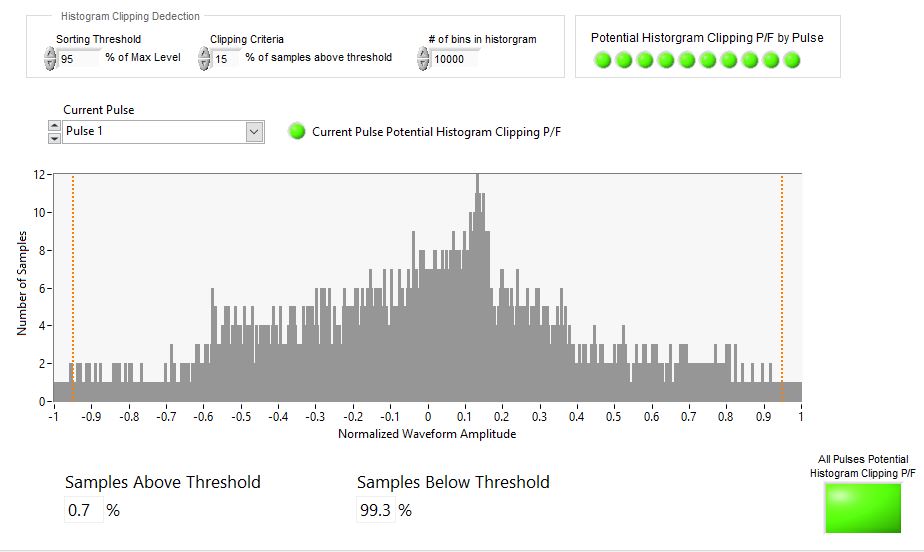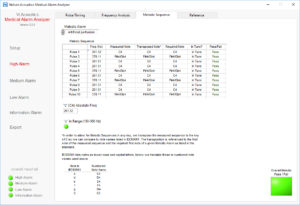Overview
 Medical Alarm Analyzer tests medical equipment alarm signals for compliance with IEC 60601-1-8 and IEC 60601-2-24 requirements using audio WAV file recordings of the alarm signal.
Medical Alarm Analyzer tests medical equipment alarm signals for compliance with IEC 60601-1-8 and IEC 60601-2-24 requirements using audio WAV file recordings of the alarm signal.
This executable, plug-and-play application will work with WAV file recordings generated from any recording device. It conducts analysis of Low, Medium and High Priority Alarms for the following characteristics:
- Pulse shape and timing
- Sound pressure level
- Clipping
- Frequency
- Melodic sequence
Medical Alarm Analyzer includes several compliance modes, enabling you to test each of the following criteria:
- IEC 60601-1-8, Amendment 1, Tables 3 & 4
- IEC 60601-1-8, Amendment 2, Tables 3 & 4
- IEC 60601-1-8, Amendment 2, Annex G
- IEC60601-2-24
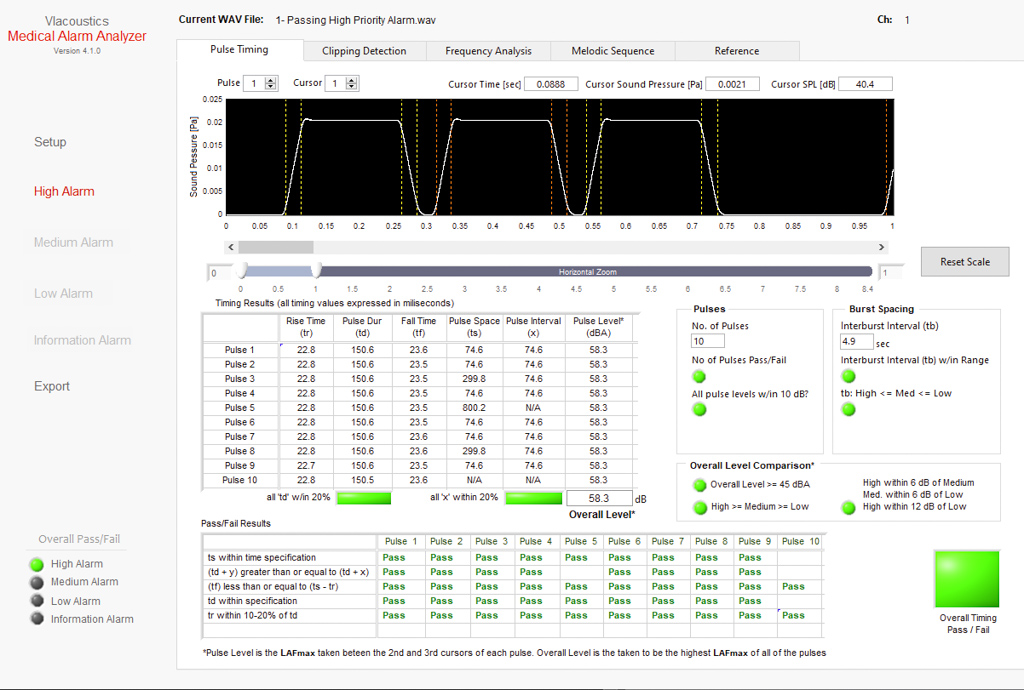
Overview
Medical Alarm Analyzer is set up to process a WAV recording of each of the four signal priority levels (High, Medium, Low and Information). 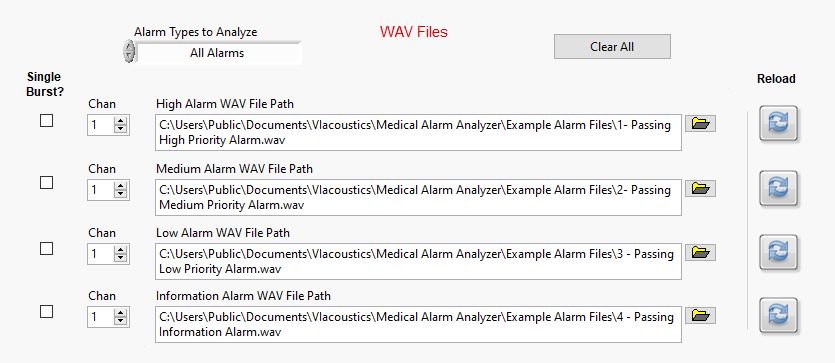
Loading a WAV file into each quickly generates an overall Pass/Fail result.
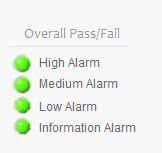
Detailed results are shown on subsequent tabs, allowing you to troubleshoot failing alarms.
Pulse Timing & Level Analysis
The IEC 60601 standards lay out timing criteria for each pulse of a medial alarm. These include rise time, duration, fall time, pulse spacing, pulse interval, and level in dBA.
Medical Alarm Analyzer automatically detects the pulses within an alarm signal. It analyzes the envelope to determine where each pulse starts and ends. A graphical display includes cursors marking the start and end of each pulse’s rise and fall.
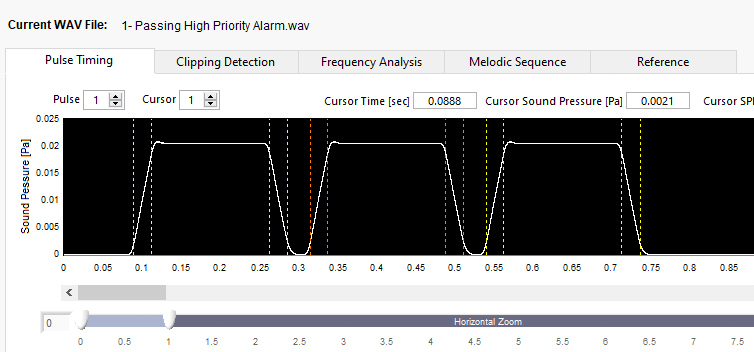
The timing results also include a table showing the following measurements for each pulse:
- Rise Time (tr)
- Pulse Duration (td)
- Fall Time (tf)
- Pulse Space (ts)
- Pulse Interval (x)
- Pulse Level (dBA)
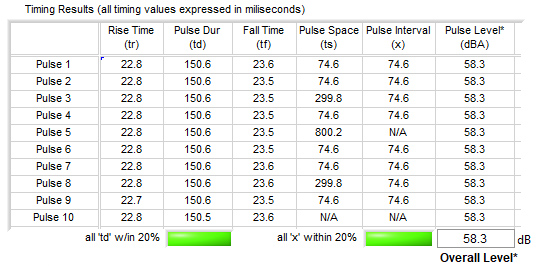
Detailed Pass / Fail results for each pulse are displayed in another table.

The standards also specify other timing and level requirements for the overall burst, including:
- Number of Pulses
- Pulse level range (within 10 dB)
- Burst Spacing range
- Relative burst spacing between High, Low and Medium Priority signals
- Overall level
- Relative levels of High, Low and Medium Priority signals
- Range of levels of High, Low and Medium Priority signals
Medical Alarma Analyzer tabulates and displays these results as well.
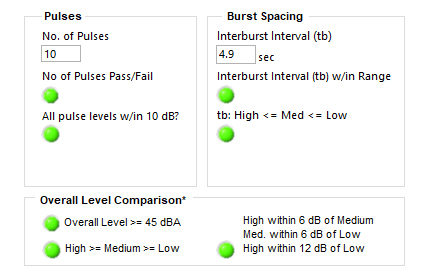
Frequency Analysis
The 60601 Standards outline a number of criteria related to frequency content of each pulse. The Frequency Analysis tab in MAA give you a quick and intuitive way to see the harmonic results for each pulse.
Medical Alarm Analyzer performs frequency domain analysis of each pulse to detect Harmonic Components. A graphical view includes adjustable cursors for the Harmonic Components in the spectrum. A set of Pass/Fail LEDs indicates whether each pulse meets all frequency based criteria.
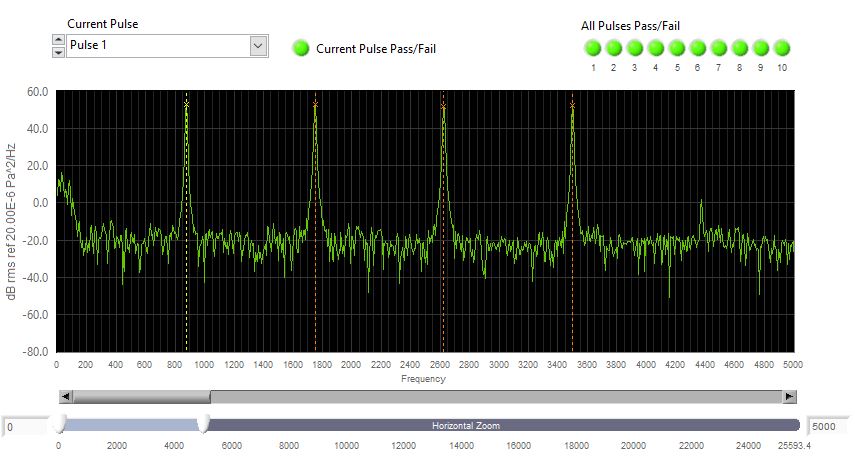
Detailed Pass/Fail results are shown for each pulse, making it easy to identity sources of failure.

Clipping Detection
IEC 60601-8 section 6.3.3.2 (e) specifies criteria Medical Alarm Analyzer includes three separate methods of clipping detection: Histogram, Time Waveform (Hard Clipping), and Spectral Balance (Soft Clipping).
The Histogram method works by performing a statistical analysis of all the samples in the pulse, and determining if a significant number of samples have a normalized level that exceeds a certain threshold. If the threshold is exceeded, clipping may have occurred.
Time Waveform method attempts to identify hard clipping by analyzing the waveform and looking for places where high level samples are repeated. If a certain percentage of the waveform contains segments of repeated samples, the detector indicates potential hard clipping.
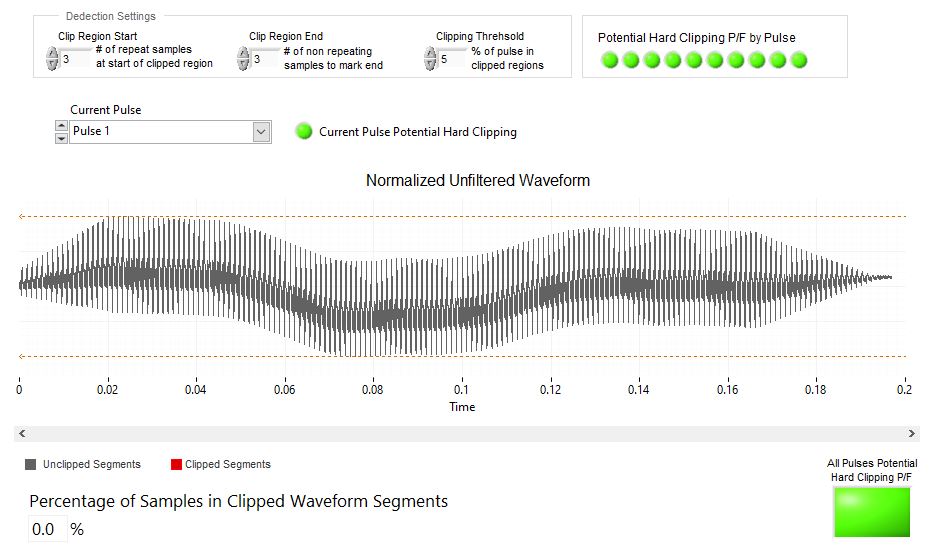
The Spectral Balance method of clipping detection uses frequency domain analysis to find potential sof-clipped signals that may be caused by analog distortion.
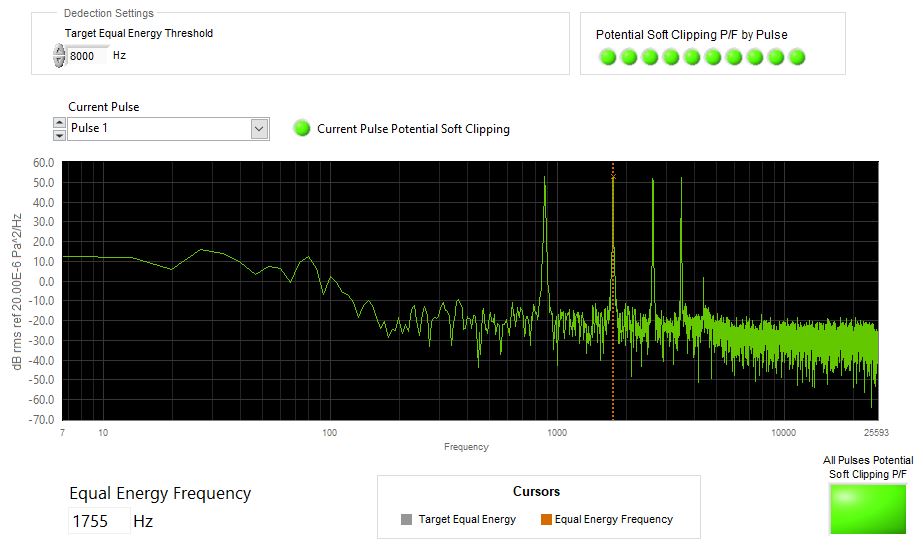
Please contact VIacoustics at "> for more information and an online demonstration of this product.
Features
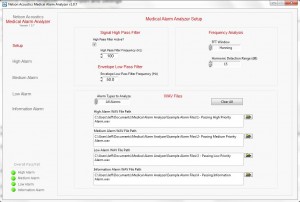 The medical alarm analyzer is designed to analyze WAV file recordings of medical alarm signals in accordance with the requirements of IEC 60610-1-8. WAV file recordings can come from any recording source. However, since audio WAV formal files are inherently uncalibrated, some method of level calibration control must be established. The Medical Alarm Analyzer provides you two ways to establish calibration levels for WAV files.
The medical alarm analyzer is designed to analyze WAV file recordings of medical alarm signals in accordance with the requirements of IEC 60610-1-8. WAV file recordings can come from any recording source. However, since audio WAV formal files are inherently uncalibrated, some method of level calibration control must be established. The Medical Alarm Analyzer provides you two ways to establish calibration levels for WAV files.
- If the recordings are made using our Trident data acquisition software, then the recordings will contain an embedded normalization terms in the file header that will automatically be read by the Medical Alarm Analyzer and your WAV files will import with calibration levels intact. For more information on out Trident software application, the National Instruments CompactDAQ device and the GRAS model 40PH microphones we would recommend for this application, click on the links associated with each product
- For recordings made with a personal computer or dedicated WAV file recording hardware, the best way to establish level calibration is to record a short signal from a sound level calibrator at the same settings to be used for your recordings. The Medical Alarm Analyzer contains a calibration tool that will allow you to specify a calibration file and calibration level, which are used to establish a normalization level for all subsequent recordings.
Medical Alarm Analyzer provides two signal conditioning tools with settings that aid in the time waveform and envelope analysis of the alarm signals.
- High Pass Filtering for alarm signals. Many time alarm signal recordings will contain low frequency noise (rumble) that is not a part of the alarm signal but will affect the time waveform characteristics of the alarm. A High Pass Filter to remove all energy below a user specified frequency will aid in the analysis of recordings with low frequency noise.
- Low Pass Filtering for Signal Envelope – The overall envelope of the signal may also have variations that are too fast to perceive and make it more difficult to determine key levels of the signal needed for the time waveform analysis. A user controlled low pass filter can limit these variations in the signal envelope.
The Medical Alarm Analyzer also provides user controlled settings for the type of FFT Analysis Window to be used (normally Hanning, but Flattop and a variety of other windowing methods are supported). In addition, users can specify the detection range, in dB, for harmonic signals in the frequency analysis.
WAV Files are retrieved for each type of alarm (High, Medium, Low and Information are supported) using a standard file browser window. The Medical Alarm analyzer contains logic for automatically detecting the start and stop times of alarm signals that are passing or near passing, and also user controllable time cursors that allow you to visually place the cursors in the time waveform for signals with unexpected time histories.
The Medical Alarm Analyzer conducts FFT frequency content analysis on each alarm signal tone burst to insure that the spectral content meets the requirements of IEC 60601-1-8 for the required number and level of harmonics of the fundamental alarm frequency.
Automated cursors locate peaks in the spectrum of the signal. For passing alarm signals, our spectral peak detection algorithms will automatically pick out the fundamental frequency and all harmonics to indicate passing signals. As with all analysis in Medical Alarm Analyzer, users may also adjust the cursors manually for alarm signals with complex spectral characteristics, often associated with non-passing alarm signals due to distortion of the audio output system.
Pass fail indication for number of harmonics within a set decibel range of the peak levels are provided.
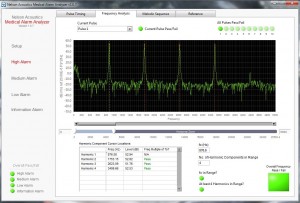
Medical Alarm Analyzer Frequency Analysis
For alarms that sound a melody, the MAA software determines the fundamental and harmonic frequency information of each pitch in the melodic sequence, then transposes the melody and compares it to the specific reserved alarm melody dictated by IEC 60601-1-8 (cardiac, artificial perfusion, ventilation, etc.). A table is generated which shows the measured frequency in Hertz and the note name, the required note, if the note is out of tune, and a pass/fail indication for each pulse in the sequence.
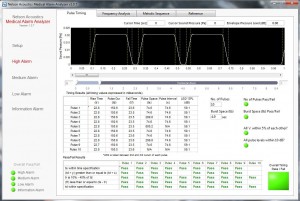 Medical Alarm Analyzer conducts time waveform analysis on medical alarm signals for compliance with the requirements of IEC 60601-1-8
Medical Alarm Analyzer conducts time waveform analysis on medical alarm signals for compliance with the requirements of IEC 60601-1-8
Time waveform analysis includes the following parameters and pass/fail analysis to the following IEC 60601-1-8 criteria.
- Alarm Signal pulse count
- Alarm Signal pulse duration
- Alarm Signal time spacing between bursts
- Alarm signal rise/fall time
- Leq sound pressure level of alarm pulses
- Relative sound pressure level check of alarm pulses
Pricing
The Medical Alarm Analyzer sells for $3,500 USD

